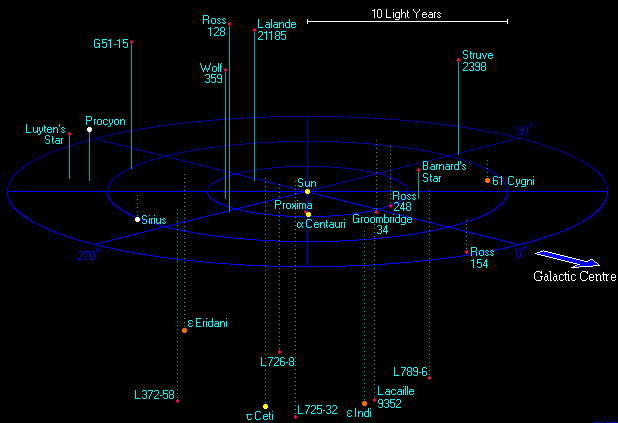
Light-year
A light-year, alternatively spelled light year (ly), is a unit of length used to express astronomical distances and is equal to exactly 9,460,730,472,580.8 km (Scientific notation: 9.4607304725808 × 1012 km), which is approximately 5.88 trillion mi. As defined by the International Astronomical Union (IAU), a light-year is the distance that light travels in a vacuum in one Julian year (365.25 days).[2] Because it includes the word "year", the term is sometimes misinterpreted as a unit of time.[3]
This article is about the unit of length. For other uses, see Light year (disambiguation).The light-year is most often used when expressing distances to stars and other distances on a galactic scale, especially in non-specialist contexts and popular science publications.[3] The unit most commonly used in professional astronomy is the parsec (symbol: pc, about 3.26 light-years).[2]
As defined by the International Astronomical Union (IAU), the light-year is the product of the Julian year[note 1] (365.25 days, as opposed to the 365.2425-day Gregorian year or the 365.24219-day Tropical year that both approximate) and the speed of light (299792458 m/s).[note 2] Both of these values are included in the IAU (1976) System of Astronomical Constants, used since 1984.[5] From this, the following conversions can be derived. The IAU-recognized abbreviation for light-year is "ly",[2] although other standards like ISO 80000:2006 (now superseded) have used "l.y."[6][7] and localized abbreviations are frequent, such as "al" in French, Spanish, and Italian (from année-lumière, año luz and anno luce, respectively), "Lj" in German (from Lichtjahr), etc.
Before 1984, the tropical year (not the Julian year) and a measured (not defined) speed of light were included in the IAU (1964) System of Astronomical Constants, used from 1968 to 1983.[8] The product of Simon Newcomb's J1900.0 mean tropical year of 31556925.9747 ephemeris seconds and a speed of light of 299792.5 km/s produced a light-year of 9.460530×1015 m (rounded to the seven significant digits in the speed of light) found in several modern sources[9][10][11] was probably derived from an old source such as C. W. Allen's 1973 Astrophysical Quantities reference work,[12] which was updated in 2000, including the IAU (1976) value cited above (truncated to 10 significant digits).[13]
Other high-precision values are not derived from a coherent IAU system. A value of 9.460536207×1015 m found in some modern sources[14][15] is the product of a mean Gregorian year (365.2425 days or 31556952 s) and the defined speed of light (299792458 m/s). Another value, 9.460528405×1015 m,[16] is the product of the J1900.0 mean tropical year and the defined speed of light.
Abbreviations used for light-years and multiples of light-years are
History[edit]
The light-year unit appeared a few years after the first successful measurement of the distance to a star other than the Sun, by Friedrich Bessel in 1838. The star was 61 Cygni, and he used a 160-millimetre (6.2 in) heliometre designed by Joseph von Fraunhofer. The largest unit for expressing distances across space at that time was the astronomical unit, equal to the radius of the Earth's orbit at 150 million kilometres (93 million miles). In those terms, trigonometric calculations based on 61 Cygni's parallax of 0.314 arcseconds, showed the distance to the star to be 660,000 astronomical units (9.9×1013 km; 6.1×1013 mi). Bessel added that light takes 10.3 years to traverse this distance.[20] He recognized that his readers would enjoy the mental picture of the approximate transit time for light, but he refrained from using the light-year as a unit. He may have resisted expressing distances in light-years because it would reduce the accuracy of his parallax data due to multiplying with the uncertain parameter of the speed of light.
The speed of light was not yet precisely known in 1838; the estimate of its value changed in 1849 (Fizeau) and 1862 (Foucault). It was not yet considered to be a fundamental constant of nature, and the propagation of light through the aether or space was still enigmatic.
The light-year unit appeared in 1851 in a German popular astronomical article by Otto Ule.[21] Ule explained the oddity of a distance unit name ending in "year" by comparing it to a walking hour (Wegstunde).
A contemporary German popular astronomical book also noticed that light-year is an odd name.[22] In 1868 an English journal labelled the light-year as a unit used by the Germans.[23] Eddington called the light-year an inconvenient and irrelevant unit, which had sometimes crept from popular use into technical investigations.[24]
Although modern astronomers often prefer to use the parsec, light-years are also popularly used to gauge the expanses of interstellar and intergalactic space.
Related units[edit]
Distances between objects within a star system tend to be small fractions of a light-year, and are usually expressed in astronomical units. However, smaller units of length can similarly be formed usefully by multiplying units of time by the speed of light. For example, the light-second, useful in astronomy, telecommunications and relativistic physics, is exactly 299792458 metres or 1⁄31557600 of a light-year. Units such as the light-minute, light-hour and light-day are sometimes used in popular science publications. The light-month, roughly one-twelfth of a light-year, is also used occasionally for approximate measures.[34][35] The Hayden Planetarium specifies the light month more precisely as 30 days of light travel time.[36]
Light travels approximately one foot in a nanosecond; the term "light-foot" is sometimes used as an informal measure of time.[37]